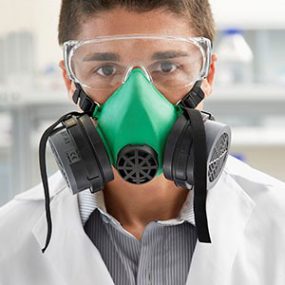OSHA Healthcare Standards
Examples of OSHA standards related to healthcare include the Bloodborne Pathogen (BBP) Standard and Personal Protective Equipment (PPE) Standard. Both standards require employers to protect workers from occupational exposure to infectious agents.

Photo by Getty Images
The Bloodborne Pathogen Standard:
- Requires employers of workers who may be exposed to blood or other potentially infectious materials, such as certain tissues and body fluids, to provide safeguards to protect workers against health hazards related to bloodborne pathogens. Provisions include exposure control plans, engineering and work practice controls, hepatitis B vaccination, hazard communication and training, and recordkeeping.
- Applies to all workers with occupational exposure to blood or other potentially infectious materials such as saliva during dental procedures and other body fluids in situations where it is difficult or impossible to differentiate between body fluids (e.g., synovial, pericardial, urine, feces).
- Requires the use of Universal Precautions, an approach to infection control in which workers treat all human blood and certain human body fluids as if they are known to be infectious, to protect against pathogens.
In 1996, CDC recommended the term and use of Standard Precautions, which includes hand hygiene, the use of certain types of PPE based on anticipated exposure, safe injection practices, and safe management of known or suspected to be infectious patients. (See OSHA Bloodborne Pathogens – Worker Protections against Occupational Exposure to Infectious Diseases).

Photo by Getty Images
The Respiratory Protection Standard:
- Is designed to protect the health of employees from harmful dusts, fogs, fumes, mists, gases, smokes, sprays, or vapors. It applies to all occupational exposures to contaminated air when airborne concentrations exceed an action level or as a standard precaution (e.g., protection against infectious agents).
- Requires respiratory protection when effective engineering controls (e.g., enclosure or confinement of the operation, local exhaust ventilation) are not feasible or not fully effective.
- Requires employers to provide appropriate respirators (suitable for the intended purpose) properly fitted to employees when necessary to protect the health of employees until the workplace implements other more effective controls.
- Requires workplaces using respirators to establish a Respiratory Protection Program.
An effective respiratory protection program must cover the following factors:
- Written worksite-specific procedures
- Program evaluation
- Selection of an appropriate NIOSH-approved respirator
- Training
- Fit testing
- Inspection, cleaning, maintenance, and storage of respirators
- Medical evaluation and determination of employee’s ability to wear a respirator
- Work area surveillance
- Air quality standards
The OSHA Hospital Respiratory Protection Program Toolkit also provides recommendations and descriptions of mandatory safety and health standards.
